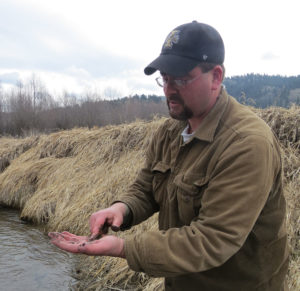Reading the Story of the Land through Soils

On June 14th, soil scientist Luke Cerise discussed the soil environment at the Triple Creek site north of Chesaw, on the ground with community members. In this event, we learned about the living layer of the earth, soil; where air, water, minerals, and a vast array of macro and microscopic organisms make life on land possible. Climactic processes (such as freeze-thaw & weathering) have acted upon geologic processes (such as glaciation & volcanism) over billions of years to create sand, silt, and clay that make up what is considered soil.
“Soil without microbes is just weathered rock,” Luke says. “Soil organisms consume plant material, recycle and make nutrients available, filter and purify contaminates out of water moving through the soil profile, and many other ecosystem services; it is truly where the magic happens.” The Okanogan Highlands have a rich geologic history that very few were witness to, but we can look for clues hidden within the soil and compare that with contemporary geologic information to read the land for clues into the past. “Soils help to tell the story of a particular place, like reading a book, and this event provides a way to help see the pages.”
Luke Cerise earned a Bachelor of Science in Forest & Range Ecology from the University of Idaho, and went on to earn a Masters degree in Soil & Land Resources, from the same university. Between the USDA Natural Resources Conservation Service (NRCS) and the USDA Forest Service, Luke has worked seven years as a professional soil scientist. He was drawn to study soil science because it is the foundation of terrestrial ecology and provides us with so many ecological services–fiber, food, clean water and countless others–but soil is still shrouded in a certain mystery of how these intricate processes function.